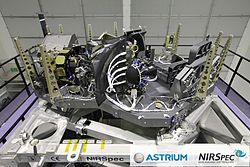 NIRSpec Instrument within the Astrium Cleanroom in Ottobrunn, Germany | |
| Mission type | Astronomy |
|---|---|
| Operator | ESA with contributions from NASA |
| Website | ESA Europe Astrium Germany NASA United States |
| Mission duration | 5 years (design) 10 years (goal) |
| Spacecraft properties | |
| Manufacturer | Astrium |
| Launch mass | 196 kg (432 lb)[1] |
| Start of mission | |
| Launch date | December 25, 2021 |
| Rocket | As part of JWST onboard Ariane 5 |
| Launch site | Kourou ELA-3 |
| Contractor | Arianespace |
| Main telescope | |
| Type | Spectrograph |
| Wavelengths | 0.6 μm (orange) to 5.0 μm (near-infrared) |
The NIRSpec (Near-Infrared Spectrograph) is one of the four scientific instruments flown on the James Webb Space Telescope (JWST).[2] The JWST is the follow-on mission to the Hubble Space Telescope (HST) and is developed to receive more information about the origins of the universe by observing infrared light from the first stars and galaxies. In comparison to HST, its instruments will allow looking further back in time and will study the so-called Dark Ages during which the universe was opaque, about 150 to 800 million years after the Big Bang.
The NIRSpec instrument is a multi-object spectrograph and is capable of simultaneously measuring the near-infrared spectrum of up to 100 objects like stars or galaxies with low, medium and high spectral resolutions. The observations are performed in a 3 arcmin × 3 arcmin field of view over the wavelength range from 0.6 μm to 5.0 μm. It also features a set of slits and an aperture for high contrast spectroscopy of individual sources, as well as an integral-field unit (IFU) for 3D spectroscopy.[3] The instrument is a contribution of the European Space Agency (ESA) and is built by Astrium together with a group of European subcontractors.[4]
- ^ "Extracting Information From Starlight". NASA. 2010-03-30. Retrieved 2014-04-09.
- ^ Greenhouse, M. (2013). MacEwen, Howard A; Breckinridge, James B (eds.). "The JWST science instrument payload: mission context and status". Proceedings of SPIE. UV/Optical/IR Space Telescopes and Instruments: Innovative Technologies and Concepts VI. 8860: 886004. Bibcode:2013SPIE.8860E..04G. doi:10.1117/12.2023366. S2CID 173183643.
- ^ Ferruit, P.; et al. (2012). Clampin, Mark C; Fazio, Giovanni G; MacEwen, Howard A; Oschmann, Jacobus M (eds.). "The JWST near-infrared spectrograph NIRSpec: status". Proceedings of SPIE. Space Telescopes and Instrumentation 2012: Optical, Infrared, and Millimeter Wave. 8442: 84422O. Bibcode:2012SPIE.8442E..2OF. doi:10.1117/12.925810. S2CID 123316716.
- ^ "ESA Science & Technology: NIRSpec – the Near-Infrared Spectrograph on JWST". Sci.esa.int. 2013-09-06. Retrieved 2013-12-13.
© MMXXIII Rich X Search. We shall prevail. All rights reserved. Rich X Search
